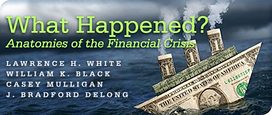I accept Larry White’s correction with respect to the word “liquidity.” The conventional language — that we distinguish between situations in which organizations are illiquid and those in which organizations are insolvent — is, I think, confusing at some level. After all, if there is no doubt that some organization is solvent why should it ever be illiquid? In an extreme, its own paper would be good enough. I think that what we usually call “liquidity” is actually made up of two different things — call them “duration” and “information.” Assets that mature in the future are illiquid in that they have unusually low prices today to the extent that there is unusually high time preference — that people really want money now. But assets that mature soon can also be illiquid in the sense of having low prices if you try to sell them when people suspect that you are cherry-picking (or, better, pit-giving) — that there is something wrong with this particular asset that makes it not a good proxy for its class — and the belief that there is something wrong with this asset can be triggered simply by your attempt to sell it.
I think that there is a big difference between me and Larry White in our view of what fundamental values are. You see, I start from something like a utilitarian’s dream — a belief that the rate of (safe) time preference ought to be on the order of 2% per year (2 percent growth in productivity times an elasticity of intertemporal substitution of 1) and that the equity risk premium ought to be on the order of 0.2% per year (the covariance of stock returns with consumption times a coefficient of relative risk aversion of 1). Thus if the market were working well — if we were using our financial markets to mobilize the full risk-bearing capacity of society — expected equity cash flows ought to be discounted at a real rate of 2.2% per year, Treasury bonds ought to yield a real rate of 2% per year, and every intermediate class of debt ought to have an expected value produced by a real discount rate in that extremely narrow range.
Thus practically every risky asset, all the time, sells for much less than its fundamental value — and does so because financial markets do not do a good job of mobilizing the risk-bearing capacity of society. I don’t think we have any prospect of living in a world in which financial markets do their job of risk-tolerance-mobilization well — nobody should trade or invest in anticipation of such a world. But I don’t think that the idea of “overinvestment” makes a lot of sense: the proper public policy response to every situation that White would characterize as one of “overinvestment” is, I think, one in which the government takes steps to mobilize more of society’s risk-bearing capacity rather than letting asset prices collapse and create massive unemployment.
I have to drop out of this virtual conversation now to take part in a real one in Vienna, but I will be back…

